A
Dstant Valley This
is the a story from a distant valley in the Bolivian Andes mountains. Paris and
London were 'home' to the social nobility who lived there and it is hard to imagine
the isolation of the place at the turn of the 19th century. Back
in those days most of the world looked to Bolivia for her wealth. The country
had a long mining history traced to long before the Inkas. Few people in Europe
knew of the way the Bolivians led their lives. Few really cared. As long as silver
gold and tin flowed from the rich veins of the mountains, Bolivia ' promised the
earth'.
Silver In those days the capital of the
country was Sucre, a city founded by Spaniards in 1540 under the name of Villa
de La Plata - or the 'Town of The Silver'.
Rebellion
Sucre is still the capital although the seat of government moved to La Paz in
1899 after a series of rebellions. Sucre has remained cut-off from the world almost
ever since.
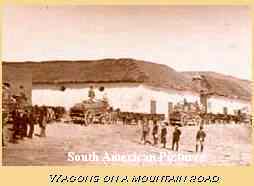 There
was a brief period when a rail connection linked it to La Paz but that has gone.
In the days when this story began the only way to travel was by horse or for short
distances by carriage. Mules hauled wagons carrying ore and supplies between the
mines, Sucre, and the nearest port on the Pacific coast 480kms away. There
was a brief period when a rail connection linked it to La Paz but that has gone.
In the days when this story began the only way to travel was by horse or for short
distances by carriage. Mules hauled wagons carrying ore and supplies between the
mines, Sucre, and the nearest port on the Pacific coast 480kms away.
The
Silver Mine
Perhaps the most famous of the 19th century mines was at Huanchaca near
Pulacayo, a cold even more remote township set at an altitude of over 4,000m. 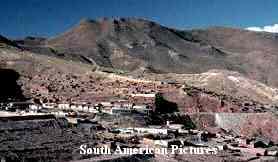 Pulacayo
is slightly northeast from Uyuni, today best known for its huge salt pans.
In 1890 the Huanchaca mine was owned by a group known as the 'Compañia
Huanchaca de Bolivia' . The Huanchaca mine was rich - very rich and
it made a lot of money. Also it attracted substantial investment from Europe,
largely from Great Britain and France. The major shareholders included the President,
a number of Chileans and some wealthy Sucre luminaries including Don
Francisco Argandoña who owned a private bank. Pulacayo
is slightly northeast from Uyuni, today best known for its huge salt pans.
In 1890 the Huanchaca mine was owned by a group known as the 'Compañia
Huanchaca de Bolivia' . The Huanchaca mine was rich - very rich and
it made a lot of money. Also it attracted substantial investment from Europe,
largely from Great Britain and France. The major shareholders included the President,
a number of Chileans and some wealthy Sucre luminaries including Don
Francisco Argandoña who owned a private bank.
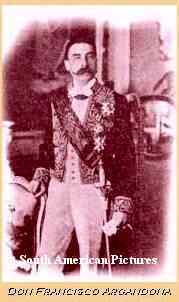 Don
Francisco
was married to Clotilde Urioste Velasco a young woman from Sucre, whose
family had arrived from Spain at the beginning of the 19th century. Don
Francisco
was married to Clotilde Urioste Velasco a young woman from Sucre, whose
family had arrived from Spain at the beginning of the 19th century.
Together
they were a central part of Sucre society, and devoted some of their wealth to
the foundation of a 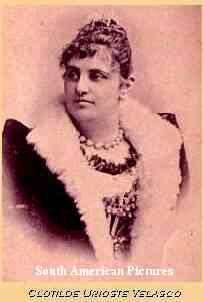 religious
house for the 'Daughters of Santa Ana'. It
became known as the 'Santa Clotilde Home'. By the 1890s everything was rolling
along well for the Francisco and Clotilde. Francisco had been awarded several
'diplomatic' titles including 'Minister Plenipotentiary in Germany', religious
house for the 'Daughters of Santa Ana'. It
became known as the 'Santa Clotilde Home'. By the 1890s everything was rolling
along well for the Francisco and Clotilde. Francisco had been awarded several
'diplomatic' titles including 'Minister Plenipotentiary in Germany',
- "remember just how far away that was - at least a week to the
port and six or seven weeks more to Europe by boat via Cape Horn.The Panama canal
didn't exist." More
Amazing Titles
Sometime between 1895 and 1899 Francisco was accorded the further title of 'Special
Envoy and Minister Plenipotentiary in France'. Francisco and Clotilde
had a Parisian home near the Arc de Triomphe in Avenida Victor Hugo. By 1898 Francisco
and Clotilde were enjoying the fruits of their diplomatic excursion in Europe.
They were en route to Russia via the Vatican when they called on the Pope. 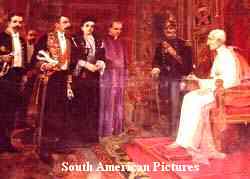 His
Holiness Pope Leon XlIl bestowed on the pair another title , 'Princes
of the Glorieta'. They continued to St Petersburg where they were entertained
by the Russian Court of the day. The list of engagements, social meetings and
honours continued or so the stories were told. Bolivia, Russia and the Vatican
were months of travel apart. His
Holiness Pope Leon XlIl bestowed on the pair another title , 'Princes
of the Glorieta'. They continued to St Petersburg where they were entertained
by the Russian Court of the day. The list of engagements, social meetings and
honours continued or so the stories were told. Bolivia, Russia and the Vatican
were months of travel apart. |